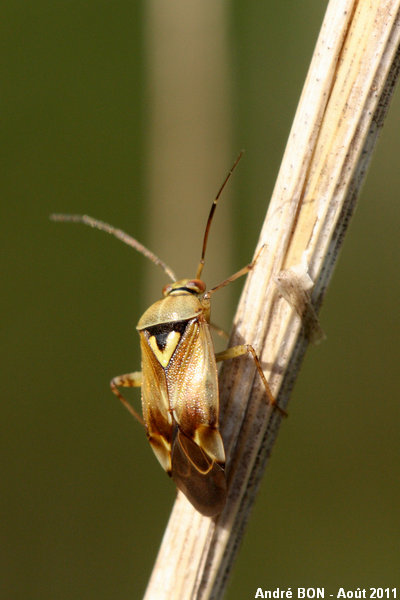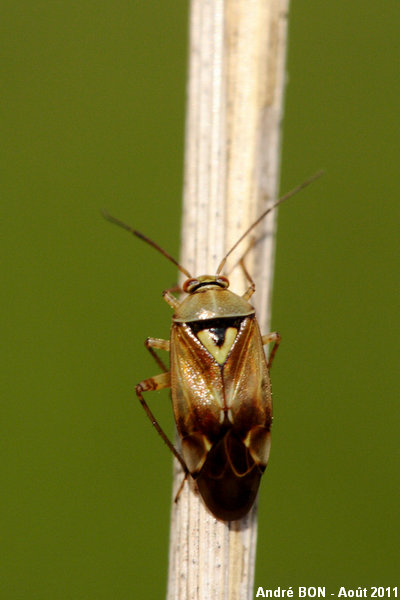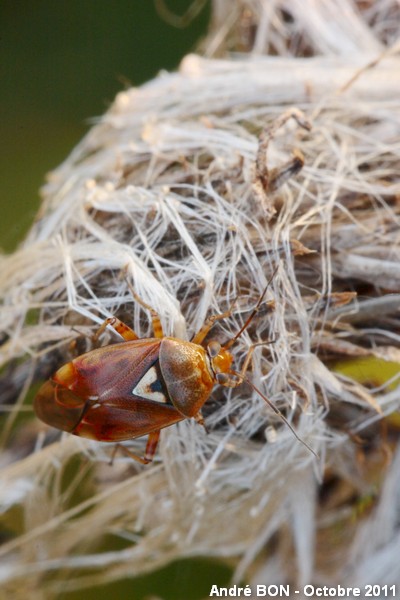


| Lygus pratensis (Linnaeus, 1758) |



|
|
Scientific name: Lygus pratensis (Linnaeus, 1758) Common name: French name: Order: Heteroptera Family: Miridae Wingspan : 5.8-7.3 mm. Biotope: Grassy places and low growing plants in open and shady habitats, meadows, waste lands, woodlands. Geographic area: Europe, Asia, North America. Observation period : Adults are observed all year long. Females lay their eggs in May-June. The development of larvae is very fast and the new generation of adults appears since July. Adults over winter under the litter, under moss or under tree bark. |
The bugs of the Miridae family, also called plant bugs, leaf bugs and grass bugs, have antennae and rostrum of 4 articles. The membranous part of the hemelytra shows two closed cells. Lygus pratensis is variable in colour. Males are rather reddish brown to dark red while females are rather pale brown to greenish. The pronotum is variable in colour. It may show dark patches, sometimes longitudinally oriented and widening at the rear. The scutellum bears a heart-shaped or V-shaped white mark bordered with black. The tip of the cuneus is always black. There are several similar species and it is very difficult to tell them apart without a close binocular exam. Species are then told apart based on the punctuation and pubescence on the corium. Lygus pratensis shows a uniform punctuation on the corium with dense regularly spaced punctures. The pubescence is uniform and the length of the hairs is such as each hair just overlap the next inline. The transverse space between the bases of two hairs is slightly shorter than the length of one hair. The pubescence is much more reduced and the shorter hairs are clearly much more spaced on Lygus maritimus and Lygus punctatus. The bases of the hairs are just slightly more transversely spaced on Lygus wagneri, about the length of one hair. On the contrary, on Lygus rugulipennis, the transverse distance between two hair bases is about half of the length of one hair. This gives a less shiny appearance. Only Lygus rugulipennis and Lygus wagneri show a uniform punctuation on the whole corium. The other species, Lygus punctatus, Lygus gemellatus, Lygus maritimus and Lygus italicus show smooth areas next to the apex. Miridae of the Orthops genus are a smaller size. The antennae are dark. Hairs on the scutellum are erected while they are lying down (if any) on the Miridae of the Lygus genus. |
| [To know more about the Lygus pratensis] [Next picture] [Top] |

|
I have only shot two pictures of this plant bug. The white mark on the scutellum is rather flared and draws a V-shape. On the non-reduced picture, I can clearly see the regular spaced punctuation covering all the corium. The pubescence seems to show an important transverse spacing so this allow to discard the Lygus rugulipennis species. The transverse spacing between the bases of the hairs seems to match the Lygus wagneri species but the quality of the picture is not enough to discard Lygus pratensis. |
| [To know more about the Lygus pratensis] [Next picture] [Previous picture] [Top] |

|
This picture, which is slightly less sharp than the previous one, does provide anything more to tell species apart. |
| [To know more about the Lygus pratensis] [Previous picture] [Top] |

|
The corium seems to me uniformly punctuated. Hairs are not visible. The antennae are not black. So we cannot tell more than Lygus sp. The reddish brown colour seems to indicate one male. |